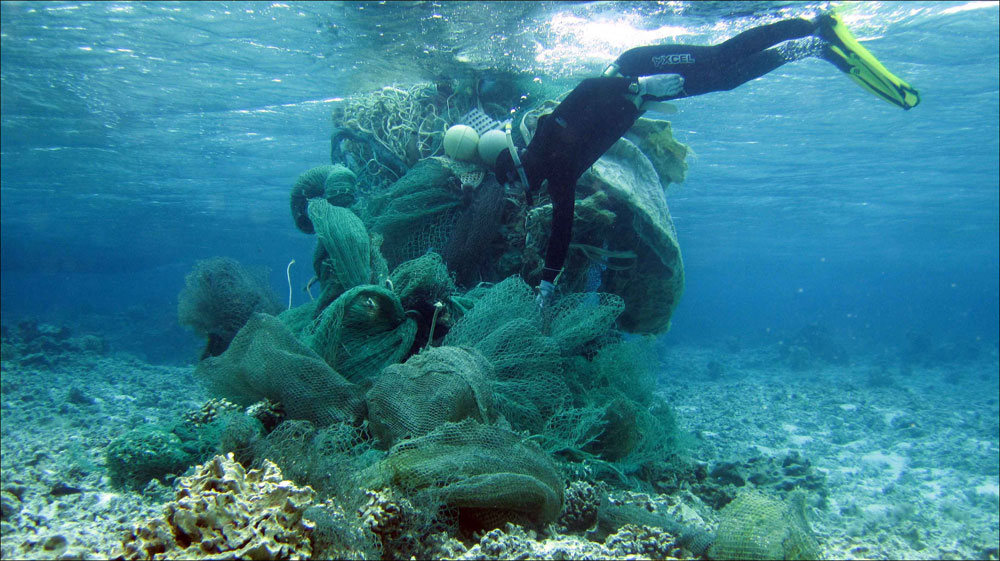Hawaii Ocean Debris Could Fill 18-Wheeler

In an area of Hawaii, far removed from most human habitation, a recent cleanup effort yielded an 18-wheeler's worth of human debris during a 19-day anti-pollution campaign this year.
The region, which includes Midway Atoll, some 1,200 miles (1,900 kilometers) from the Hawaiian mainland, acts as a "fine-tooth comb" in picking up debris from elsewhere, officials with the National Oceanic and Atmospheric Administration (NOAA) told LiveScience. Broken fishing gear, tattered nets and plastic fragments litter the water and land on the beaches.
As challenging as it is to clean up that much debris, it's even more of an undertaking to remove it. Heavy machinery could damage the environment, so about 90 percent of the underwater cleanup is done by divers, said Kyle Koyanagi, NOAA's marine debris operations manager.
"They physically go down and remove the net little by little with pocket knives, slowly cutting away at the debris that is entangled," Koyanagi said. "They remove it from that environment, pull it in with their arms, hands and back, and transport it in small vessels on to larger support vessels."
NOAA does this campaign every year, but the annual budget is in "soft money," Koyanagi said, which means it's vulnerable to budgetary effects such as sequestration.
Cleanup changes every year
The Coral Reef Ecosystem Division Marine Debris Project, run by NOAA's Pacific Islands Fisheries Science Center, has collected 848 tons (769 metric tons) of debris —about the weight of 530 sedan-size cars —in the northwestern Hawaiian Islands since the program began in 1996.
Get the world’s most fascinating discoveries delivered straight to your inbox.
Efforts began after pollution was identified as a major threat to monk seals, an endangered species native to Hawaii. Decades of built-up pollution required NOAA to spend anywhere from 60 to 120 days at sea between 2000 and 2005, when intensive anti-pollution measures began in earnest. [Video: Humans Hit the Oceans Hard]
With the buildup now addressed, the agency has now been in "maintenance mode" since 2006, picking up whatever gets washed into the area annually. A typical field season lasts 30 to 60 days.
"We put together an annual effort every year depending on our budget that gets allocated," said Mark Manuel, NOAA's marine ecosystems research specialist. "It will be some kind of survey effort, whether a shore-based, three-week mission or an extensive, two-month cleanup [at sea]."
Turning nets to energy
The amount of debris collected varies wildly from year to year. Surveyed areas in Hawaii include the French Frigate Shoals, Kure Atoll, Laysan Island, Lisianski Island, Maro Reef, Midway Atoll and Pearl and Hermes Atoll.
This year's efforts stayed on the shore due to budgetary concerns, Koyanagi added, which likely reduced the amount of debris collected, even though it could have filled a big rig.
"As you can imagine, the ship time is very expensive," Koyanagi said. "Because of budget cuts this year, we could not afford to do a full-blown effort and get to the remote atolls."
Once the debris is picked up, NOAA works to recycle as much of it as possible. Nets, for example, are sent to Schnitzer Steel Hawaii Corp. on the mainland, where they are chopped up for the City and County of Honolulu's H-Power plant to convert into electricity.
The facility, run by Covanta Energy, burns the nets and generates steam, which is used to drive a turbine and create electricity.
Follow Elizabeth Howell @howellspace. Follow us @livescience, Facebook& Google+. Original article on LiveScience.com.

Elizabeth Howell was staff reporter at Space.com between 2022 and 2024 and a regular contributor to Live Science and Space.com between 2012 and 2022. Elizabeth's reporting includes multiple exclusives with the White House, speaking several times with the International Space Station, witnessing five human spaceflight launches on two continents, flying parabolic, working inside a spacesuit, and participating in a simulated Mars mission. Her latest book, "Why Am I Taller?" (ECW Press, 2022) is co-written with astronaut Dave Williams.




